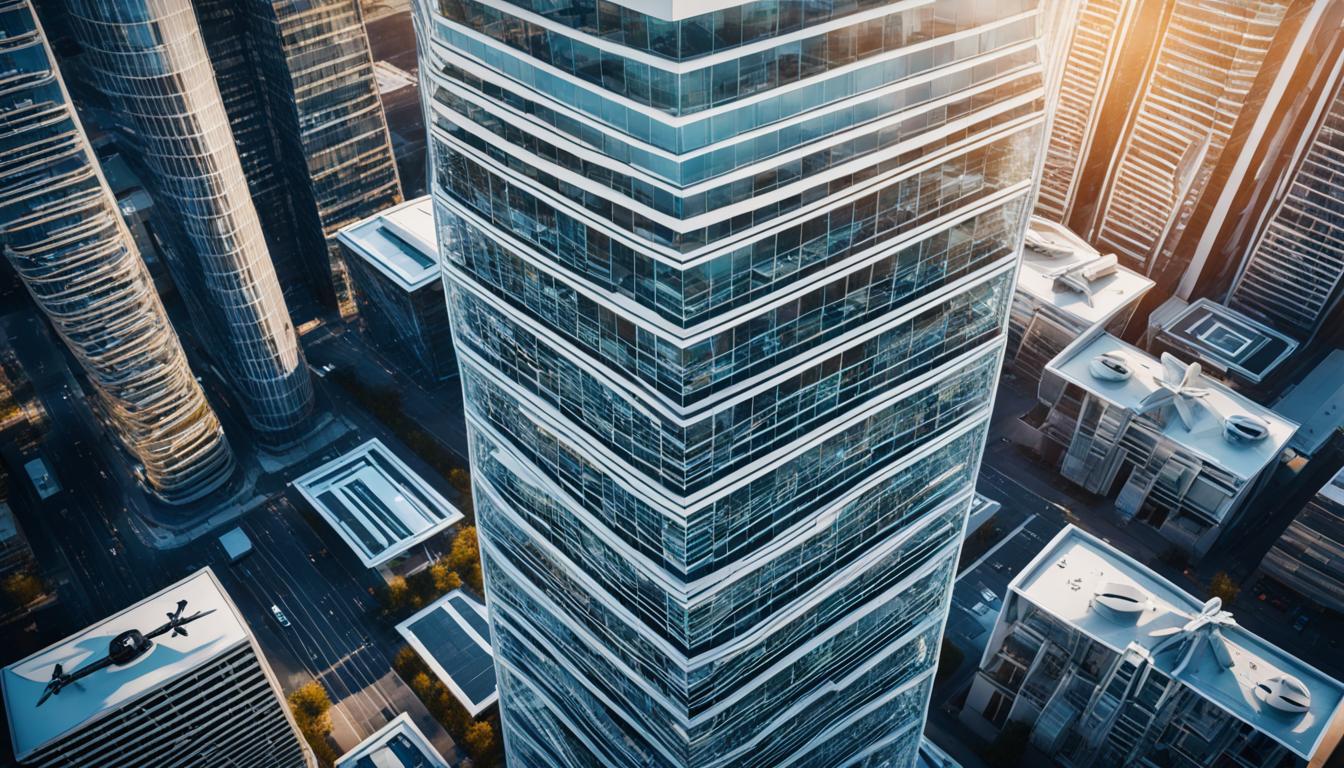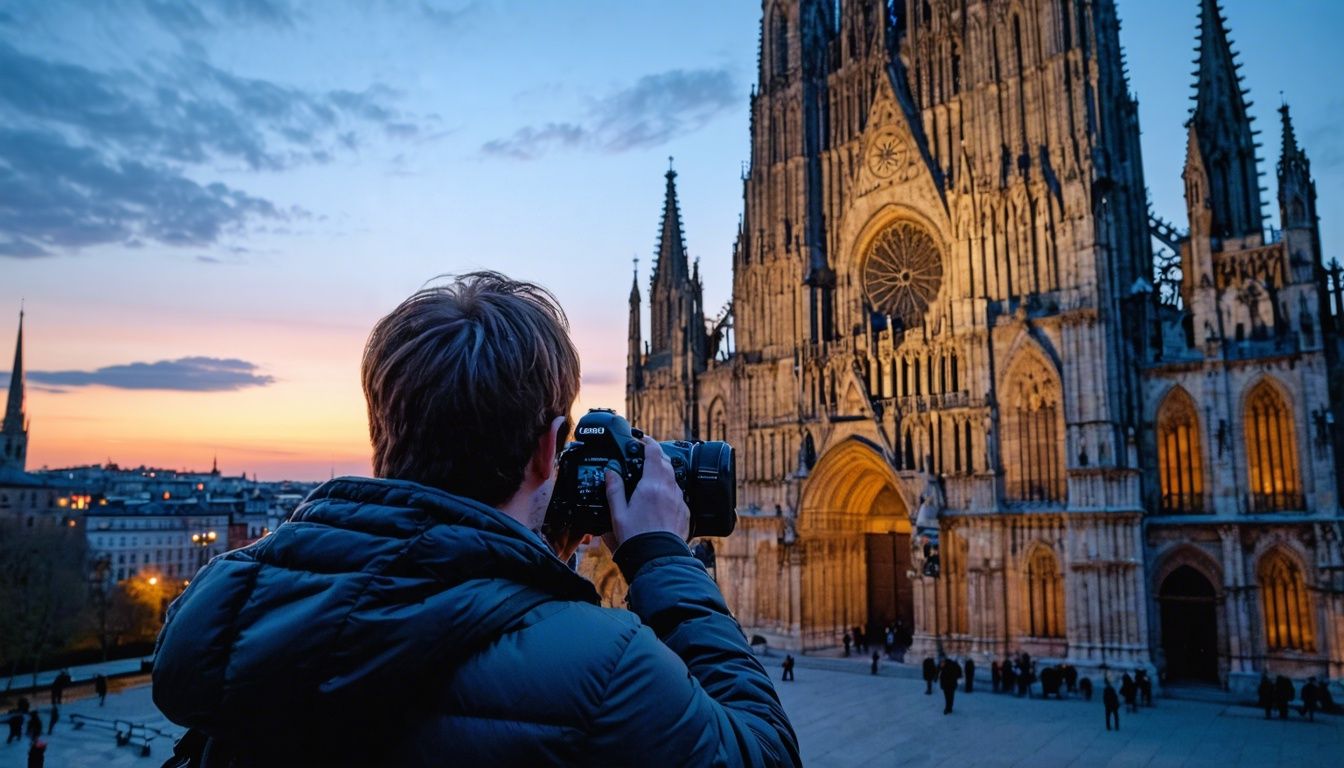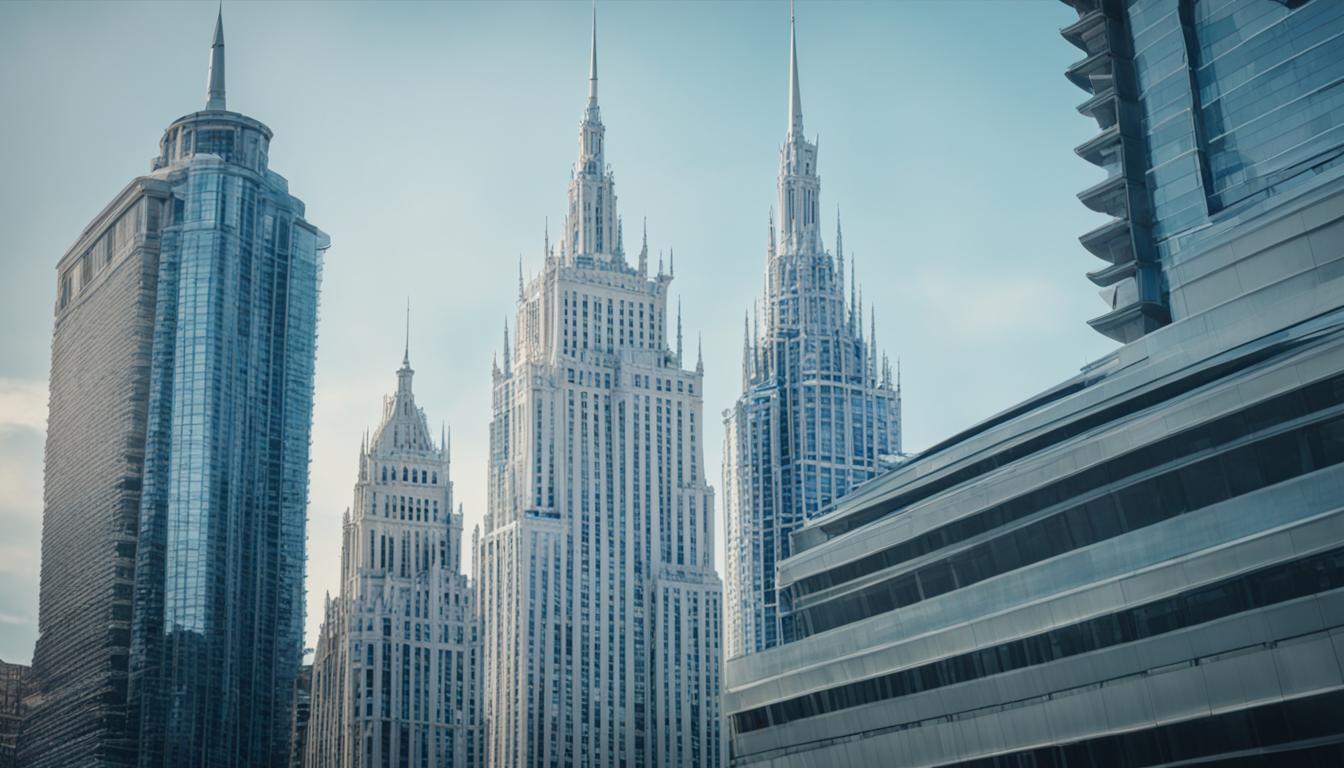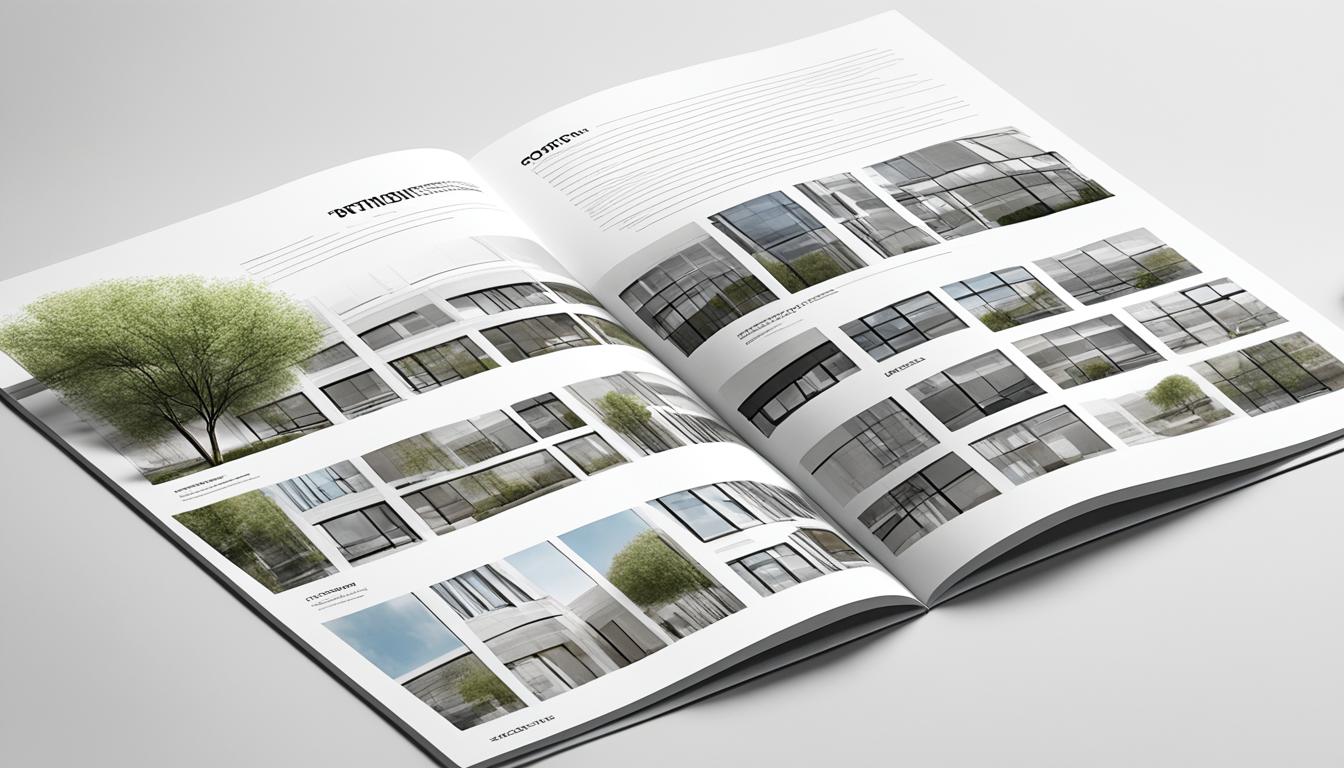In today’s digital age, drones have revolutionized the field of architectural photography, allowing us to capture breathtaking aerial views and showcase the beauty of buildings from a unique perspective. As architects and photographers, we understand the immense value that drone photography brings to our projects. Whether you are an architect looking to document your designs or a photographer specializing in architectural shots, drone photography opens up a world of possibilities.
One of the most experienced professionals in using drones for architectural photography is Fernando Guerra, a renowned architect and architectural photographer. He has seamlessly integrated drones into his workflow, harnessing their capabilities to capture stunning shots that highlight the scale, design, and intricate details of buildings.
However, it’s essential to remember that utilizing drones for architectural photography comes with regulations and guidelines that we must adhere to. Understanding these rules not only ensures our safety but also helps us navigate the legal requirements of operating drones in architectural photography.
Key Takeaways:
- Drone photography offers a new perspective and a holistic representation of the built environment.
- Architectural drone photography techniques involve using high-spec drones equipped with cameras to capture detailed shots of buildings and landscapes.
- Regulations and guidelines for drone photography are in place to ensure the safety of manned aircraft and the public.
- Planning your flight, considering composition and framing, and experimenting with camera settings can enhance your drone photography in architecture.
- Gear and accessories such as high-quality memory cards, ND filters, and lanyards can enhance your drone photography experience.
The Role of Drones in Architectural Design and Photography
At present, drones are playing a pivotal role in both architectural design and photography, revolutionizing the way architects and photographers capture and showcase buildings and landscapes. Renowned architect and photographer Fernando Guerra has seamlessly integrated drones into his workflow, harnessing their capabilities to capture breathtaking aerial views and gather essential data for architectural projects. By utilizing high-spec drones equipped with advanced camera systems, architectural drone photography has become more accessible, allowing professionals to create detailed and visually stunning shots of buildings and their surroundings.
Architectural drone photography techniques involve employing drones equipped with specialized cameras that provide exceptional image quality, enabling architects and photographers to capture intricate architectural details, textures, and perspectives that were previously unattainable. These techniques open up new horizons, providing a unique and fresh perspective on architectural design, and enriching the overall visual narrative.
When it comes to choosing the best drone for architecture photography, several factors come into play. The camera quality is of utmost importance, as it determines the level of detail and clarity in the captured images. Additionally, flight time is a critical consideration, as longer flight durations allow for more extensive coverage and increased creativity. Another vital feature is obstacle avoidance technology, which ensures safe and obstacle-free flights, minimizing the risk of accidents and damage to the drone.
| Factors to Consider for Choosing the Best Drone for Architecture Photography |
|---|
| Camera Quality |
| Flight Time |
| Obstacle Avoidance Technology |
The table above summarizes the key factors to consider when selecting a drone for architecture photography. Evaluating these factors and choosing a drone that excels in each category will ensure optimal results in capturing architectural beauty from aerial perspectives.
With the help of drones, architects and photographers are now empowered to visualize and communicate designs in new and innovative ways. By leveraging the unique capabilities of drones in the architectural design process and photography, professionals can create captivating visuals that highlight the beauty, scale, and intricate details of buildings and landscapes.
Regulations and Guidelines for Drone Photography
When it comes to drone photography, understanding and complying with the regulations and guidelines is of utmost importance for architects and photographers. The Federal Aviation Administration (FAA) in the United States has collaborated with industry organizations to educate users about safe and responsible drone operation. These regulations have been implemented to ensure the safety of both manned aircraft and the general public.
In order to operate a drone for photography purposes, there are requirements and rules that need to be followed. One of the essential requirements is obtaining a remote pilot certificate from the FAA. This certificate demonstrates your knowledge and understanding of aviation regulations and safety procedures.
Additionally, registering your drone with the FAA is mandatory for all drones weighing between 0.55 pounds (250 grams) and 55 pounds (25 kilograms). This registration ensures accountability and helps in the event of any incidents or accidents.
When flying a drone for architectural photography, it is crucial to adhere to specific flight rules and guidelines. These include flying under 400 feet (122 meters) above ground level, maintaining a visible line of sight with the drone, and avoiding operations in restricted airspace such as airports and national parks.
To provide further clarity on the regulations and guidelines for drone photography, reference local laws and regulations applicable to your location. Drone laws can vary across different countries and regions, so it’s essential to stay informed and comply with the rules.
| Regulation/Guideline | Explanation |
|---|---|
| Remote Pilot Certificate | Demonstrates knowledge and understanding of aviation regulations and safety procedures. |
| Drone Registration | Mandatory for drones weighing between 250 grams and 25 kilograms to ensure accountability. |
| Flight Rules | Includes flying under 400 feet above ground level, maintaining visual line of sight, and avoiding restricted airspace. |
| Adherence to Local Laws | Important to check and follow the specific laws and regulations in your country or region. |

By understanding and adhering to drone photography regulations and guidelines, architects and photographers can ensure safe and responsible operations while capturing stunning aerial views of architectural projects.
Tips for Drone Photography in Architecture
When it comes to architectural photography with drones, there are several tips and techniques that can help elevate your shots and capture stunning images of buildings and landscapes. Our team of experts has compiled a list of valuable insights to enhance your drone photography skills in architecture.
1. Planning and Pre-Flight Checklist
Before taking your drone for a flight, proper planning and preparation are crucial. Create a pre-flight checklist to ensure a smooth and successful operation. Consider factors such as battery life, wind conditions, and potential obstacles in the flight path. By thoroughly planning, you can avoid unnecessary challenges and focus on capturing remarkable architectural shots.
2. Composition and Framing
Architecture is all about design and aesthetics, and the same holds true for drone photography in architecture. Take the time to explore different angles, perspectives, and heights to showcase the building’s unique features and design elements. Experiment with compositions that highlight the architectural details, such as leading lines, symmetry, and interesting patterns. Framing your shots carefully will enhance the visual impact and create captivating imagery.
3. Utilize Camera Settings
The camera settings on your drone play a crucial role in capturing the details and textures of the architecture. Experiment with exposure settings to ensure proper lighting and highlight the building’s key elements. Adjust the focus to capture sharp and well-defined images. Take advantage of the drone’s capabilities to shoot in RAW format, allowing for more flexibility in post-processing and enhancing image quality.
4. Embrace Different Perspectives
One of the significant advantages of drone photography in architecture is the ability to capture unique aerial perspectives. Don’t limit yourself to traditional ground-level shots. Explore aerial angles that offer a fresh and captivating view of the building and its surroundings. Consider incorporating the context of the landscape into your compositions, showcasing how the architecture interacts with its environment.
5. Post-Processing and Editing
Once you’ve captured your architectural drone shots, don’t forget the importance of post-processing and editing. Use professional photo editing software to bring out the best in your images. Adjust exposure, contrast, and color balance to enhance the visual impact. Remember to maintain a natural and realistic look while still accentuating the architectural details.
With these tips in mind, you’re well on your way to creating stunning architectural drone shots. Remember to always prioritize safety, follow regulations, and respect the privacy of others while operating your drone.
Gear and Accessories for Drone Photography
To enhance your drone photography experience, there are various gear and accessories you can consider. Whether you’re a professional architect or an avid drone photographer, having the right equipment can significantly elevate your aerial photography game. From the best drone for architecture photography to essential accessories that optimize your workflow, we’ve got you covered.
Choosing the Best Drone for Architecture Photography
When it comes to architectural photography, selecting the right drone is crucial. Consider factors such as camera quality, flight time, and portability to find a drone that meets your specific needs.
One highly recommended option is the DJI Phantom 4 Pro, known for its exceptional image quality and stability during flight. With a 20-megapixel camera, 4K video capabilities, and obstacle avoidance technology, it’s a reliable choice for capturing stunning architectural shots.
ND Filters for Drone Photography
ND (Neutral Density) filters are essential tools for controlling the amount of light that enters your drone’s camera sensor. These filters enable you to achieve longer exposures and capture creative effects such as motion blur and light trails.
A popular ND filter set among photographers is the PolarPro Cinema Series. These filters are crafted with high-quality glass and precision-engineered to ensure accurate color reproduction while reducing glare and unwanted reflections.
Best Memory Cards for Drone Photography
When you’re capturing high-resolution images and shooting videos in 4K, having reliable and fast memory cards is crucial. To prevent data loss and ensure smooth operation, invest in high-quality memory cards with sufficient storage capacity.
The SanDisk Extreme Pro series is widely regarded as one of the best memory cards for drone photography. With fast writing speeds and ample storage space, these cards allow you to capture multiple shots without interruption.
Drone Accessories
Enhance your drone photography workflow with various accessories designed to optimize performance and convenience. Here are some accessories worth considering:
- Remote controller lanyards for added comfort during long flights.
- Protective cases to safeguard your drone during transportation.
- Extra batteries for extended flight time and uninterrupted shooting.
- Propeller guards to protect your drone during indoor flights or close-quarters maneuvering.
- Helipads for landing and takeoff in adverse terrain conditions.
By equipping yourself with the right gear and accessories, you can maximize the potential of your drone and capture breathtaking architectural shots. Experiment with different tools and techniques to push the boundaries of your creativity.
| Drone Model | Camera Quality | Flight Time | Obstacle Avoidance Technology |
|---|---|---|---|
| DJI Phantom 4 Pro | 20 megapixels | Approximately 30 minutes | Yes |
Advantages of Using ND Filters
“ND filters allow me to capture long-exposure shots of architectural marvels, creating a mesmerizing blend of movement and static elements. They truly add an artistic touch to my drone photography.” – Fernando Guerra, Architectural Photographer
Top Memory Card Brands for Drone Photography
- SanDisk
- Samsung
- Lexar
- Transcend

Investing in the right gear and accessories is essential for taking your drone photography to new heights. From choosing the best drone for architecture photography to leveraging ND filters and high-quality memory cards, these tools will help you capture stunning aerial shots with ease and creativity.
Using Drones for Specific Architectural Photography Projects
Drones are versatile tools that can be utilized in various architectural photography projects, providing unique perspectives and elevating the overall visual experience. Two specific applications of drone photography in the architectural field include drone wedding photography and real estate marketing drone photography.
Drone Wedding Photography
Drone wedding photography offers a captivating way to capture precious moments and create lasting memories. By utilizing drones, photographers can showcase the wedding venue, the surrounding landscape, and the bride and groom from aerial angles, resulting in breathtaking and cinematic shots. These aerial perspectives add a touch of grandeur to the wedding album, providing a unique and immersive viewing experience for the couple and their loved ones.
When conducting drone wedding photography, it is essential to consider flight planning and adhere to safety guidelines. Ensuring that the drone is operated within legal and ethical boundaries is crucial for the safety of everyone involved. Additionally, understanding the specific requirements and preferences of the couple allows photographers to tailor their approach and create personalized aerial compositions that align with the couple’s vision.
Real Estate Marketing Drone Photography
In the world of real estate marketing, drones have become indispensable tools for showcasing properties from extraordinary angles. Aerial views captured by drones provide potential buyers with a comprehensive understanding of the property’s features, location, and surroundings. By highlighting the scale and design of buildings, drones help market properties in a visually striking and impactful manner.
Photographers and real estate agents can benefit from the use of drones by capturing stunning aerial shots of the property’s exterior, showcasing its architecture and landscaping. These images not only attract the attention of potential buyers but also offer them the opportunity to appreciate the location and neighborhood from a bird’s-eye view. Ultimately, real estate marketing drone photography takes property presentations to the next level, helping buyers envision their future homes or investments with greater clarity.
Summary
| Application | Benefits | Considerations |
|---|---|---|
| Drone Wedding Photography |
|
|
| Real Estate Marketing Drone Photography |
|
|
The Advantages and Challenges of Drone Photography
Drone photography offers numerous advantages for architectural photography, enabling us to capture unique aerial perspectives, showcase the scale and design of buildings, and provide a holistic representation of the built environment. With drones, we can take stunning aerial shots that were previously impossible to obtain, allowing us to capture the full beauty and grandeur of architectural structures.
One of the key advantages of drone photography is its ability to save time and resources. Traditionally, capturing aerial views of buildings required expensive methods such as scaffolding, cranes, or even helicopter photography. Drones offer a cost-effective alternative that eliminates the need for these expensive and sometimes dangerous approaches.
“Drones provide a unique vantage point that allows us to see buildings in a new light. The aerial perspective showcases the architecture from a dynamic angle, emphasizing its form, lines, and spatial relationships in a visually captivating way.” – Fernando Guerra
In addition to cost savings, drone photography also presents certain challenges. One of the main challenges is navigating legal and regulatory restrictions. Drone operators need to abide by regulations set by aviation authorities, such as the Federal Aviation Administration (FAA) in the United States. These regulations include obtaining a remote pilot certificate, registering the drone, and adhering to specific flight rules to ensure the safety of manned aircraft and the public.
Another challenge of drone photography is ensuring safety during flight operations. Piloting a drone requires skill and practice, as well as careful planning to avoid obstacles and potential hazards. Wind conditions, battery life, and flight range are factors that need to be considered to ensure a safe and successful operation.
Lastly, managing the technical aspects of operating a drone and capturing high-quality images can be a challenge. Proper understanding of camera settings, such as exposure and focus, is essential for capturing sharp and well-exposed photographs. Additionally, post-processing drone images may require specialized software and techniques to enhance and refine the final results.
Despite these challenges, drone photography continues to revolutionize the field of architectural photography, offering us unprecedented opportunities to capture breathtaking images. By understanding and overcoming these challenges, we can unlock the full potential of drone photography in capturing the beauty and intricacies of architectural designs.
Advantages of Drone Photography
- Unique aerial perspectives
- Showcasing scale and design of buildings
- Cost and time savings compared to traditional methods
Challenges of Drone Photography
- Navigating legal and regulatory restrictions
- Ensuring safety during flight operations
- Managing technical aspects of operating a drone
Conclusion
Drone photography has revolutionized the field of architectural photography, offering architects and photographers new possibilities to capture stunning aerial views and showcase the built environment. The use of drones in architecture has quickly become a valuable tool for professionals like Fernando Guerra, allowing them to capture unique perspectives and present a holistic representation of their designs.
However, it is vital to understand and comply with the regulations and guidelines surrounding drone photography. The Federal Aviation Administration (FAA) has implemented rules and restrictions to ensure the safety of manned aircraft and the public. By obtaining a remote pilot certificate, registering drones, and following flight rules, we can operate drones responsibly and legally.
Equipped with the right gear, accessories, and knowledge, architects and photographers can elevate their projects and create captivating images. By carefully planning flights, considering composition and framing, and utilizing camera settings, we can showcase the beauty and design of buildings through architecture drone shots. With the ability to capture unique aerial perspectives, drones allow us to present architecture in an entirely new light.
As we continue to embrace drone technology and adhere to regulations, we can unlock the full potential of drone photography in the field of architecture. By capturing breathtaking aerial views and showcasing the intricate details of structures, we can captivate viewers and provide a fresh perspective on the built environment. Drone photography for architecture is truly a game-changer, enabling architects and photographers to push boundaries and redefine the way we capture and appreciate architectural design.
FAQ
What is drone photography for architecture?
Drone photography for architecture involves using drones equipped with cameras to capture aerial views and detailed shots of buildings and landscapes, providing a unique perspective and a holistic representation of the built environment.
How can drones be integrated into the architectural design process?
Drones can be integrated into the architectural design process by using them to capture aerial views, gather data, and provide architects with valuable insights into their designs and the surrounding environment.
What are the regulations and guidelines for drone photography?
The regulations and guidelines for drone photography include obtaining a remote pilot certificate, registering your drone, and following specific flight rules, such as flying under 400 feet and avoiding restricted airspace. It is important to check local laws and regulations as well, as drone laws vary.
What are some tips for drone photography in architecture?
Some tips for drone photography in architecture include planning your flight, considering composition and framing, and using the drone’s camera settings to capture the details and textures of the architecture.
What gear and accessories are recommended for drone photography?
The best drone for architecture photography depends on factors such as camera quality, flight time, and obstacle avoidance technology. ND filters, high-quality memory cards, lanyards, and helipads are some recommended gear and accessories for enhancing your drone photography experience.
How can drones be used for specific architectural photography projects?
Drones can be used for specific architectural photography projects such as drone wedding photography and real estate marketing. Drone wedding photography can capture aerial shots of the wedding venue and surrounding landscape, while real estate marketing can showcase properties from stunning aerial perspectives.
What are the advantages of drone photography for architecture?
The advantages of drone photography for architecture include capturing unique aerial perspectives, showcasing the scale and design of buildings, and providing a holistic representation of the built environment. Drones can also save time and resources compared to traditional methods such as scaffolding or helicopter photography.
What are the challenges of drone photography?
Some challenges of drone photography include navigating legal and regulatory restrictions, ensuring safety during flight operations, and managing the technical aspects of operating a drone and capturing high-quality images.
How does Drone Photography for Architecture Differ from Interior and Exterior Photography?
Drone photography for architecture offers a unique perspective compared to traditional interior exterior architectural photography. Drones can capture the scale and surroundings of a building, while interior and exterior photography focuses on specific design details. The use of drones provides a bird’s-eye view, showcasing the entire architectural landscape.




